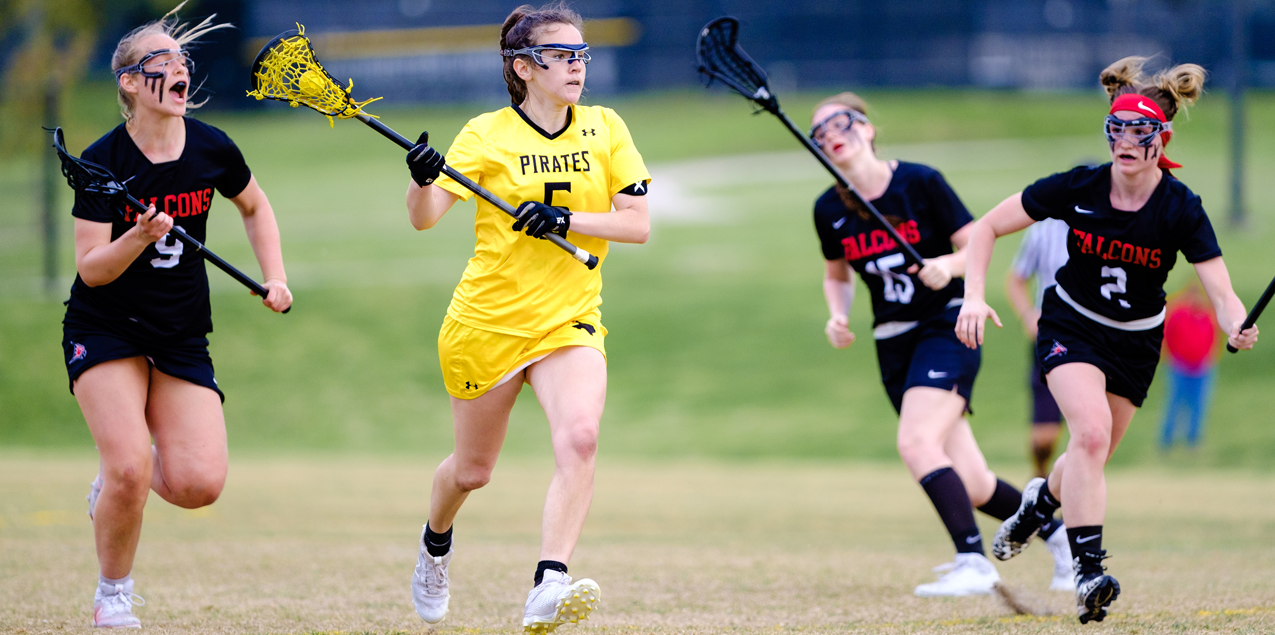GRACE MAYNARD OF SOUTHWESTERN UNIVERSITY, a senior midfielder on the women's lacrosse team from Cedar Park, Texas, has been selected the SCAC Character & Community Female Student-Athlete of the Week for the week beginning January 27.
The SCAC Character & Community award honors the efforts of student-athletes who excel in the field of athletics, and also serve their campus and community.
On the lacrosse field, Southwestern University Pirates' senior Grace Maynard’s vision—her ability to read the field and see the bigger picture—is a valued asset for a rebuilding program under the direction of first year head coach Kaitlyn Hafdell.
It’s a big reason why Maynard, a former DI player from Butler who transferred to Southwestern, was named team captain this season.
“Grace is very driven, leads by example, and has a voice,” Hafdell said. “And she uses her voice the right way, encouraging teammates to be the best player they can be. She understands the commitment of what it takes to be a student-athlete.
“She sees the field and understands the flow of the game. She has a strong lacrosse IQ.”
Those traits serve her well in the classroom and outside the walls of Southwestern University, where she served as an intern for the Michael & Susan Dell Foundation last summer in Austin.
The Dell Foundation, which was established in 1999, is “dedicated to transforming the lives of children living in urban poverty through improving their education, health and family economic stability,” according to its website. Its self-stated mission is:
“We start by identifying the people and places most in need. We then work closely with our partners to find solutions that combine bold thinking with real-world experiences and hard data. We go directly into communities and learn about families’ struggles and aspirations, then pair those most in need with proven, practical solutions to help them move forward.”
Over the summer, Maynard participated in a research project tracking the eating habits and options for residents of east Austin; specifically as it pertains to fruits and vegetables.
In 2017, an Austin/Travis County Community Health Assessment showed concern about east Austin’s predominantly African American and Hispanic residents being displaced into areas with fewer resources. From the study:
“In the CTSA, residents and professionals discussed this migration, noting that historically underserved and low-income Black/African American and Latino/Hispanic residents’ displacement into more affordable areas outside of central Austin with less access to affordable health care, healthy food retailers, outdoor recreation space, and means of transportation is significant.”
The information Maynard helped gather looked at the diet of east Austin residents, asking how often they ate fruits and vegetables, how much they spent, and where they buy from, creating a greater understanding of needs to help better allocate resources.
“With gentrification, east Austin residents can struggle to receive the appropriate resources,” Maynard said. “Often, the first thing people cut out of their budget is fruit and vegetables, even though that’s probably the most essential thing they need.
“The surveys I did gave us a bigger picture of what is needed and what is lacking so we can make suggestions for allocating resources for them.”
The internship came in conjunction with another life-changing decision for Maynard, moving her academic pursuits away from the medical field to concentrate on public health; moving away from treating patients to exploring the root causes of their issues.
“For the longest time, I thought I wanted to be in the medical field,” Maynard said. “But over the summer I realized public health is more my passion.
“My vision is to create an outreach program for underserved communities or be a health service outcomes manager with a hospital, making sure all patients receive great care.”
The internship helped gain new experiences for life off the field and on, learning how to communicate with a team in which members played different roles towards a common cause.
“Having to communicate with so many people, talking to researchers, coordinators, and people doing surveys, there was a lot of communication needed,” Maynard said. “And as a teammate, you have to communicate with your teammates and coaches; it’s essential to building a successful program.”
Part of being a leader on the field and in the community is identifying the needs and communicating where resources need to go. In both, Maynard is finding her voice and calling.
Grace Maynard, Southwestern University, Women's Lacrosse

Posted: Jan 29, 2020









